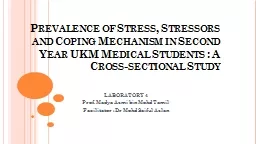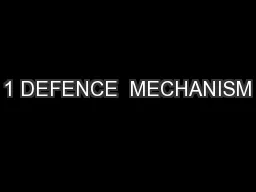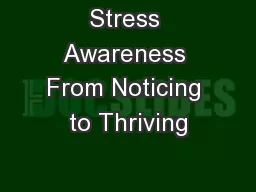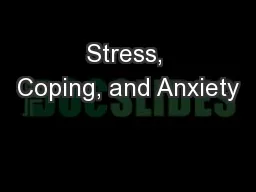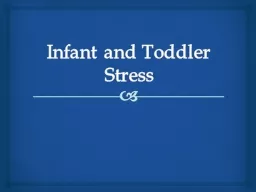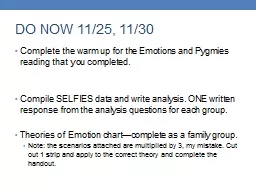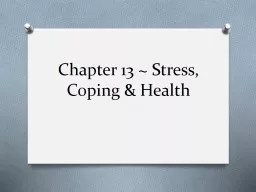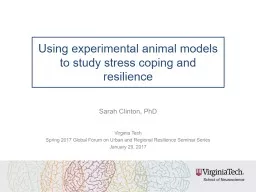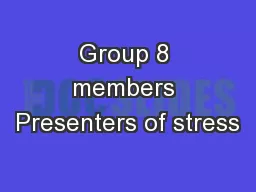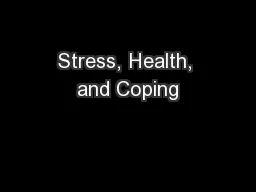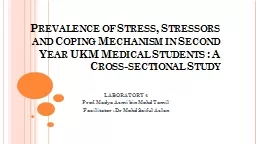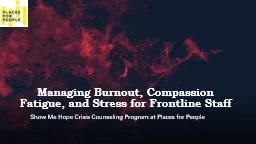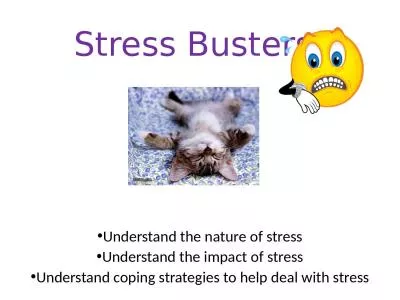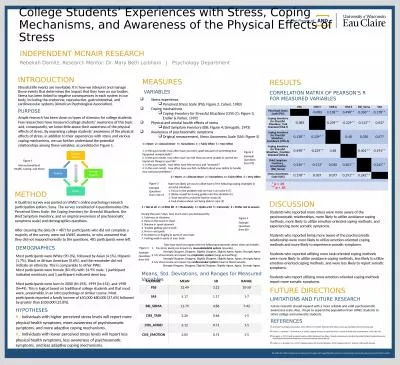PPT-Prevalence of Stress, Stressors and Coping Mechanism in Second Year UKM Medical Students
Author : motivatorprada | Published Date : 2020-08-27
LABORATORY 4 Prof Madya Azmi bin Mohd Tamil Facilitator Dr Mohd Saiful Azlan SINARAN SAMSURI GA02540 SITI NUR WARDAH BINTI ISHAK A143628 MUHAMMAD SYAHIR
Presentation Embed Code
Download Presentation
Download Presentation The PPT/PDF document "Prevalence of Stress, Stressors and Copi..." is the property of its rightful owner. Permission is granted to download and print the materials on this website for personal, non-commercial use only, and to display it on your personal computer provided you do not modify the materials and that you retain all copyright notices contained in the materials. By downloading content from our website, you accept the terms of this agreement.
Prevalence of Stress, Stressors and Coping Mechanism in Second Year UKM Medical Students: Transcript
LABORATORY 4 Prof Madya Azmi bin Mohd Tamil Facilitator Dr Mohd Saiful Azlan SINARAN SAMSURI GA02540 SITI NUR WARDAH BINTI ISHAK A143628 MUHAMMAD SYAHIR AFHAM BIN KAMARUDDIN A143655. A brief introduction to a revolutionary approach to . impact . management. In the beginning…. …We spoke of threats. Common . threats . included:. Loss of resource quantity. Loss of resource quality. A Coping Style to Everyday Life. Lt . Cdr . Habibur . Rahman Khan. 2. INTRODUCTION. Protective response of the body against disease . Physiological. Unconscious mental process to protect from shame, anxiety, loss of self-esteem, conflict, or unacceptable feelings. Lunch n Learn. 1. This presentation was developed by Organizational Wellness & Learning Systems, Inc.. Objectives. As a result of this session, participants will. Enhance their ability to notice signs of stress and more readily take action to reduce stress. NURS 329 Psychiatric . Mental . Health . Nursing. Objectives. Describe the physiological stress response. Identify symptoms and behaviors associated with anxiety responses. Analyze predisposing factors, precipitating stressors, and appraisal of stressors related to anxiety responses. With those sitting at your table, read the scenario provided. Discuss how you would feel. Report to the entire group your feelings. Imagine it was you…. Attachment. Relationships. Routine . Leaving the Parent. Compile SELFIES data and write analysis. ONE written response from the analysis questions for each group. . Theories of Emotion chart—complete as a family group. . Note: the scenarios attached are multiplied by 3, my mistake. Cut out 1 strip and apply to the correct theory and complete the handout. . Biopsychosocial . model . = physical . illness . caused . by . complex . interaction of biological, psychological, . & sociocultural . factors. . The Nature of Stress. stress =. . any circumstances that threaten or are perceived to threaten one’s well-being &. Sarah Clinton, PhD. Virginia Tech. Spring 2017 Global Forum on Urban and Regional Resilience Seminar Series. January 29, 2017. resilience. noun. 1. . the capacity to recover quickly from difficulties; toughness.. 1.Nadhiru . Nassor. . . Introduction. &Areas. affected by stress. 2.Janeth Thomas. . . Types and causes of stress. 3.Amani . Luoga. . . Effects&stress. reaction. 4.Swaibu . Nuhu. . Chapter Twelve. Stress. : . Negative emotional state occurring in response to events that are perceived as taxing or exceeding a person’s resources or ability to . cope. C. ognitive . appraisal model of . LABORATORY 4. Prof. . Madya. . Azmi. bin . Mohd. Tamil. Facilitator : . Dr. . Mohd. . Saiful. . Azlan. . SINARAN SAMSURI GA02540. SITI NUR WARDAH BINTI ISHAK A143628. MUHAMMAD SYAHIR AFHAM BIN KAMARUDDIN A143655. Show Me Hope Crisis Counseling Program at Places for People. What is Show Me Hope Missouri?. The Show Me Hope Missouri Crisis Counseling Program is a federally funded program utilized after disasters occur in communities. Understand the impact of stress. Understand coping strategies to help deal with stress. What is Stress?. Most commonly it’s a mix of anxiety (tension, nerves) and depression (feeling flat/sad). Stress is very common – we all have stress in our lives and there are times when this is worse that others. . Mechanisms, and Awareness of the Physical Effects of Stress. Rebekah Damitz, Research Mentor: Dr. Mary Beth Leibham | Psychology Department . Independent mcnair research. Stressful life events are inevitable. It is how we interpret and manage those events that determines the impact that they have on our bodies. Stress has been linked to negative consequences in each system in our body, including the endocrine, reproductive, gastrointestinal, and cardiovascular systems (American Psychological Association). .
Download Document
Here is the link to download the presentation.
"Prevalence of Stress, Stressors and Coping Mechanism in Second Year UKM Medical Students"The content belongs to its owner. You may download and print it for personal use, without modification, and keep all copyright notices. By downloading, you agree to these terms.
Related Documents

